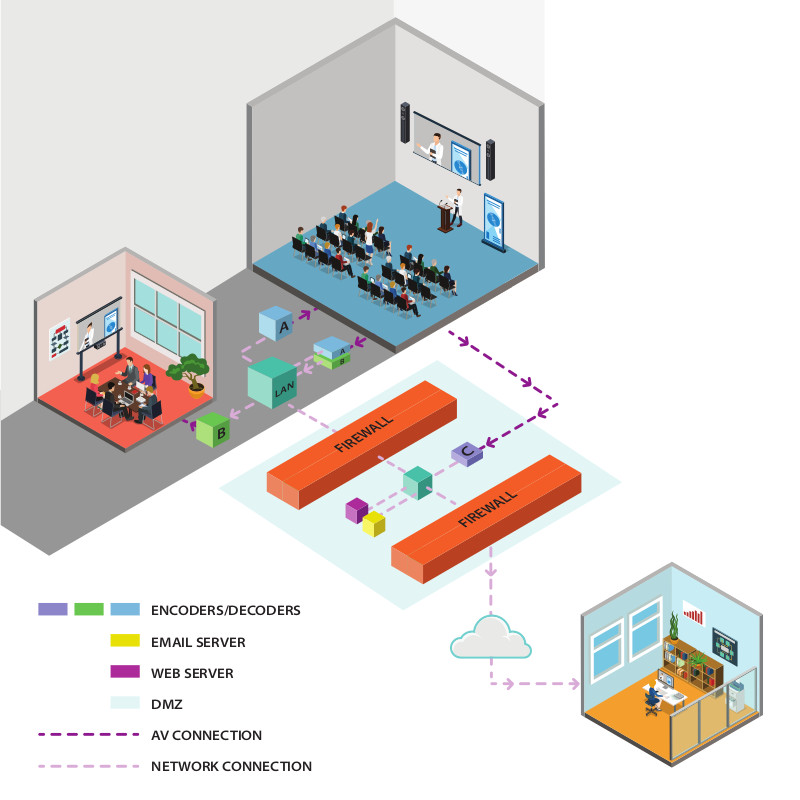In the previous installments of this series, we discussed some of the benefits of IP signal distribution, along with a few technical terms to help sift through the noise in the market. However, when network-based solutions utilize the enterprise network infrastructure, they often face the scrutiny of IT managers. As such, it is essential to both understand the IT department’s concerns and prepare yourself to address them accordingly. Although there are multiple potential pain points for IT, they come down to a few closely related technical areas; among them, the top two are security and bandwidth.
Before going further, let’s get some perspective. I anticipate that many people who read this have limited experience in AV-over-IP (AVoIP) matters. (Otherwise, why would you be reading this primer, right?) The potential appeal of this piece is to offer some form of enlightenment—or, perhaps, fear reduction—about the subject. After all, even with the convergence of AVoIP, is it reasonable to expect all AV specialists to know very much about IT? I ask that rhetorically, as it illustrates the expectation I have found from some AV professionals who (incorrectly) anticipate that IT people will understand AV.
I, too, had the same misperception that IT department heads would already know about AV. Simultaneously, my non-scientific research anecdotally shows that some IT managers assume AV people understand little about networks. As is usually true, reality doesn’t lie in generalizations. It is prudent to put aside assumptions about the person who sits across from you, and, instead, to have an open dialogue from the outset about perceptions and concerns. Sometimes, concerns can be alleviated through dialogue. Be prepared to answer the following question: “What do I need to do to my network to get this to work?”
The easiest ways to fail in implementing AVoIP is to choose an unproven solution or to use the cheapest option. Be prepared to address a whole range of issues with the IT managers. If you are unsure of the answers to the questions I introduce below, talk to the manufacturer’s support team. If the manufacturer is unable to answer your questions, then find another provider! Working with vendors that offer proven solutions, with pre-sale and post-sale support, will help maximize the potential for success.
One of the first questions to ask is whether the manufacturer offers firmware and security updates. If so, are those updates automatic? If they are not automatic, how will deployment of the latest patches be ensured? It’s also good to ask how much bandwidth the solution requires.
Most network traffic outside of AV is bursty, which means there are usage surges, which are followed by lulls. Imagine you are shopping online. While the vendor webpage loads, network traffic increases. After the site loads, downloading stops while you read the page, only to resume with the next click. In between, the network is free to handle other tasks, such as email or web surfing by colleagues. By comparison, sending real-time audio and video over the network is constant, and, therefore, it consistently demands higher bandwidth.

Speaking of bandwidth, not all network switches are created equal. We typically hear of switches rated by their port speed (for example, 1Gb). However, the port speed does not mean all ports can pass data at the same time at that rate. The backplane speed is the maximum amount of data that a switch can forward at one time, regardless of the number of ports in use. When deploying an AVoIP solution, whether on a dedicated network or riding on the organization’s existing infrastructure, the backplane of switches must support the required data throughput. Additionally, keep in mind that some AVoIP standards (i.e., AVB/TSN) require specially certified switches.
Does the IT department have to open ports on the firewall? If so, which ones? Opening ports on a firewall creates work for IT and has the potential to increase security risks. Some AVoIP solutions sit inside the corporate firewall, others are outside and some go in the DMZ (a network between the internet and enterprise network, intended to provide additional security from outside threats).
How is AV traffic data prioritized? For example, does it require configuring quality of service (QoS)? Although many methodologies use DiffServ for QoS, they do not always require configuration. For instance, although Dante uses QoS, QoS only requires configuration as total traffic approaches maximum bandwidth utilization on a mixed-use network. At that stage, it is sometimes only necessary to configure QoS for the audio clock, rather than for all the audio data.
IT managers might want to know if the proposed methodologies use unicast (from one source to one destination) or multicast (from one to many). Not all network managers are comfortable with multicast on their networks, because it potentially increases bandwidth consumption and it’s thought to send the same content everywhere on a network. However, Internet Group Management Protocol (IGMP) snooping, which sounds like a bad thing, is actually a helpful method for IT managers to keep multicast traffic off portions of the network that do not have to receive the multicast data.
Keep in mind that, even if IT managers do not permit you to use their networks, some might allow you to use a virtual local area network (VLAN) if you provide insights on how the VLAN will (or will not) connect to the primary corporate local area network (LAN). Some manufacturers voluntarily assist integrators in the conversations with IT to help facilitate the adoption of their solutions.
AVoIP offers numerous benefits as compared to traditional signal distribution, even if you have to create a dedicated network entirely separate from the enterprise. Although an independent network might require pulling new cable, switches and other devices, you will have better control over the configuration, while also reducing potential conflict with nonmedia traffic. And even if you do choose a “plug-and-play” solution on a dedicated network, continue to educate yourself about networking. After all, the AV/IT convergence is here, and technology changes occur frequently.
